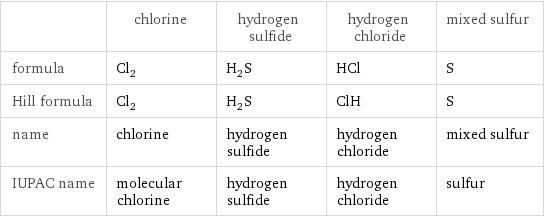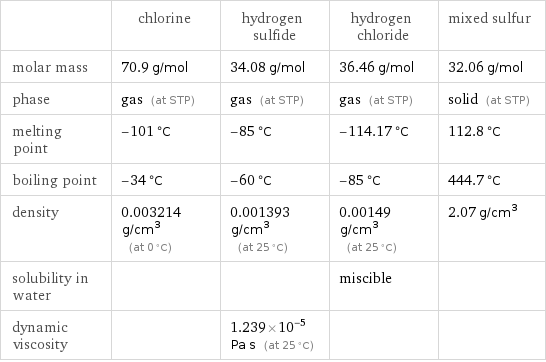Input interpretation

Cl_2 (chlorine) + H_2S (hydrogen sulfide) ⟶ HCl (hydrogen chloride) + S (mixed sulfur)
Balanced equation

Balance the chemical equation algebraically: Cl_2 + H_2S ⟶ HCl + S Add stoichiometric coefficients, c_i, to the reactants and products: c_1 Cl_2 + c_2 H_2S ⟶ c_3 HCl + c_4 S Set the number of atoms in the reactants equal to the number of atoms in the products for Cl, H and S: Cl: | 2 c_1 = c_3 H: | 2 c_2 = c_3 S: | c_2 = c_4 Since the coefficients are relative quantities and underdetermined, choose a coefficient to set arbitrarily. To keep the coefficients small, the arbitrary value is ordinarily one. For instance, set c_1 = 1 and solve the system of equations for the remaining coefficients: c_1 = 1 c_2 = 1 c_3 = 2 c_4 = 1 Substitute the coefficients into the chemical reaction to obtain the balanced equation: Answer: | | Cl_2 + H_2S ⟶ 2 HCl + S
Structures

+ ⟶ +
Names

chlorine + hydrogen sulfide ⟶ hydrogen chloride + mixed sulfur
Equilibrium constant
![K_c = ([HCl]^2 [S])/([Cl2] [H2S])](../image_source/34a6796656fb43199b98e8792736e7e7.png)
K_c = ([HCl]^2 [S])/([Cl2] [H2S])
Rate of reaction
![rate = -(Δ[Cl2])/(Δt) = -(Δ[H2S])/(Δt) = 1/2 (Δ[HCl])/(Δt) = (Δ[S])/(Δt) (assuming constant volume and no accumulation of intermediates or side products)](../image_source/69e4046b74532010c588be545fcee144.png)
rate = -(Δ[Cl2])/(Δt) = -(Δ[H2S])/(Δt) = 1/2 (Δ[HCl])/(Δt) = (Δ[S])/(Δt) (assuming constant volume and no accumulation of intermediates or side products)
Chemical names and formulas

| chlorine | hydrogen sulfide | hydrogen chloride | mixed sulfur formula | Cl_2 | H_2S | HCl | S Hill formula | Cl_2 | H_2S | ClH | S name | chlorine | hydrogen sulfide | hydrogen chloride | mixed sulfur IUPAC name | molecular chlorine | hydrogen sulfide | hydrogen chloride | sulfur
Substance properties

| chlorine | hydrogen sulfide | hydrogen chloride | mixed sulfur molar mass | 70.9 g/mol | 34.08 g/mol | 36.46 g/mol | 32.06 g/mol phase | gas (at STP) | gas (at STP) | gas (at STP) | solid (at STP) melting point | -101 °C | -85 °C | -114.17 °C | 112.8 °C boiling point | -34 °C | -60 °C | -85 °C | 444.7 °C density | 0.003214 g/cm^3 (at 0 °C) | 0.001393 g/cm^3 (at 25 °C) | 0.00149 g/cm^3 (at 25 °C) | 2.07 g/cm^3 solubility in water | | | miscible | dynamic viscosity | | 1.239×10^-5 Pa s (at 25 °C) | |
Units
